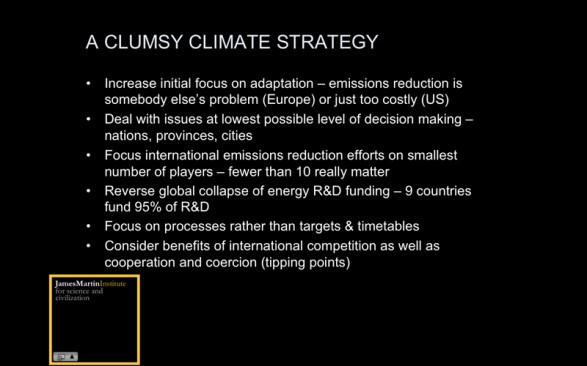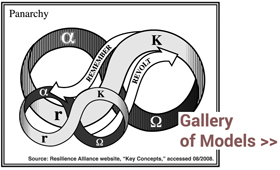[I wrote last time about Nigel Cross’s sense that design thinking can help tackle wicked problems. That post reminded me of this June 2010 one I wrote for P&P, “Clumsy Responses to Wicked Climate Problems,” reprinted in full below.]

More and more, climate change is referred to as a wicked problem, one that is “difficult or impossible to solve because of incomplete, contradictory, and changing requirements” (Wikipedia).
From Horst Rittel and Melvin Webber‘s “Dilemmas in a General Theory of Planning,” a 1973 paper that describes wicked problems:
The Enlightenment may be coming to full maturity in the late 20th century, or it may be on its deathbed. … By now we are all beginning to realize that one of the most intractable problems is that of defining problems (of knowing what distinguishes an observed condition from a desired condition) and of locating problems (finding where in the complex causal networks the trouble really lies). …
As distinguished from problems in the natural sciences, which are definable and separable and may have solutions that are findable, the problems of governmental planning — and especially those of social or policy planning — are ill-defined; and they rely upon elusive political judgment for resolution. (Not “solution.” Social problems are never solved. At best they are only re-solved — over and over again.)
Clumsiness is conceived of as a response to wickedness. From Marco Verweij and coauthors in “The Case for Clumsiness,” the introductory chapter to the book, Clumsy Solutions for a Complex World: Governance, Politics and Plural Perceptions:
The term ‘clumsy institution’ was coined by Michael Schapiro (1988) as a way of escaping from the idea that, when we are faced with contradictory definitions of problem and solution, we must choose one and reject the rest.
I reprint the slide above (with permission) from Steve Rayner‘s 2006 presentation “Wicked Problems: Clumsy Solutions.” Rayner is director of University of Oxford’s Institute for Science, Innovation and Society, and coauthor on “The Case for Clumsiness” (as well as on The Hartwell Paper and the Oxford Principles on Geoengineering).
From Rayner’s notes (Jack Beale Memorial Lecture on Global Environment):
Now, there are challenges of course for these approaches. The media and voters expect policymakers to fix problems. It is a hard sell for a policymaker to say well, you know, I’m going to wait for a clumsy solution to emerge, I’m going to make sure all the voices get heard. Policymakers, generally speaking, demand scientific bottom lines for decision-making. Although we know from the knowledge utilisation literature that they rarely use them to make policy, they still demand them. And scientists are committed to improving knowledge, so often hold out unrealistic expectations to policymakers that they will produce knowledge that will cut the Gordian knot of a wicked problem.
And we also have the hammer problem, which is the success of rational choice theory in solving more straightforward problems which exacerbates expectations for their appropriateness for application to wicked problems. We often hear that there are claims that there are no alternatives to the application of benefit cost analysis and other kinds of rational choice tools.
So there are hard challenges ahead for a clumsy approach. But, a very good friend of mine, Shiv Visvanathan, pointed out recently that democracy is not merely a design problem, it’s a challenge to the imagination. So I’m offering clumsy solutions to wicked problems as a challenge to the imagination. I believe that embracing clumsiness moves us from techniques for selecting among well defined alternatives towards looking for new skills for creating imaginative solutions.
(See a larger version of the Clumsy Climate Strategy slide.)

